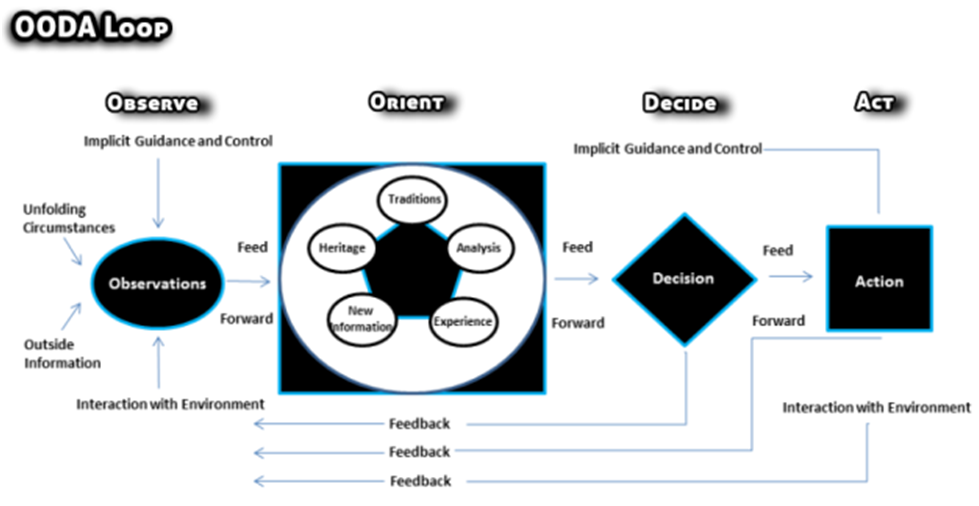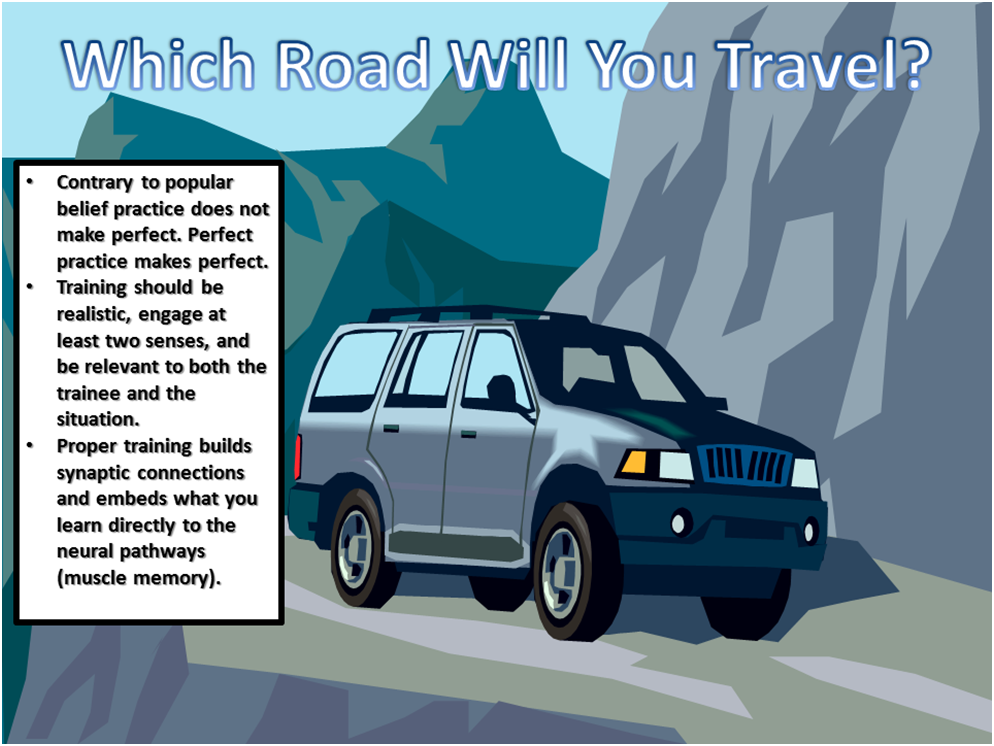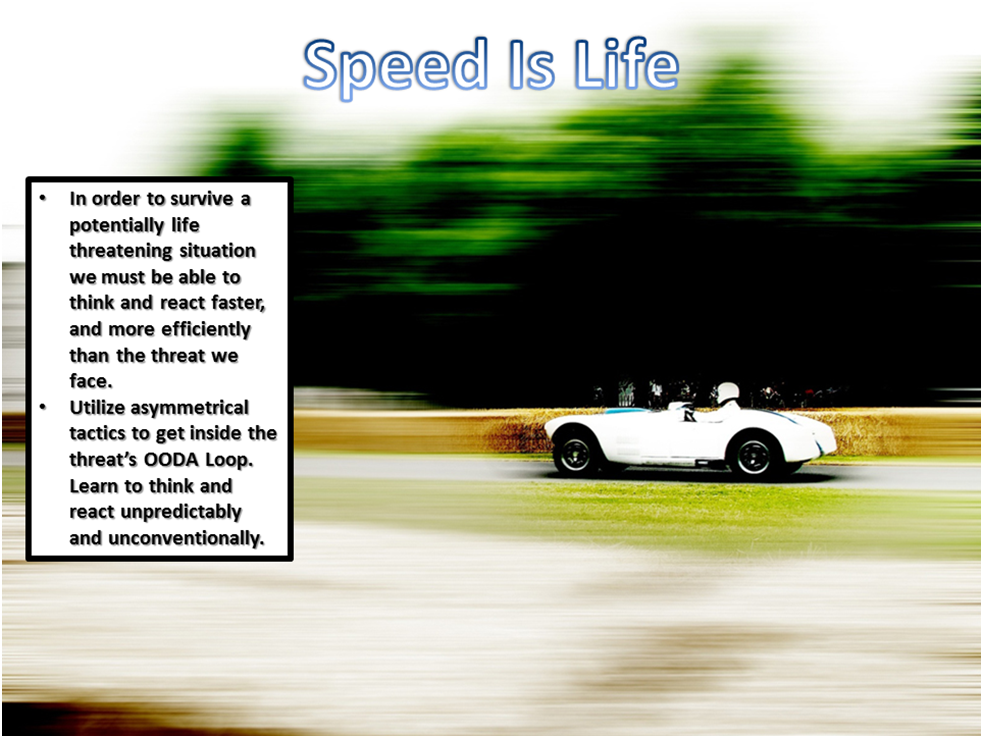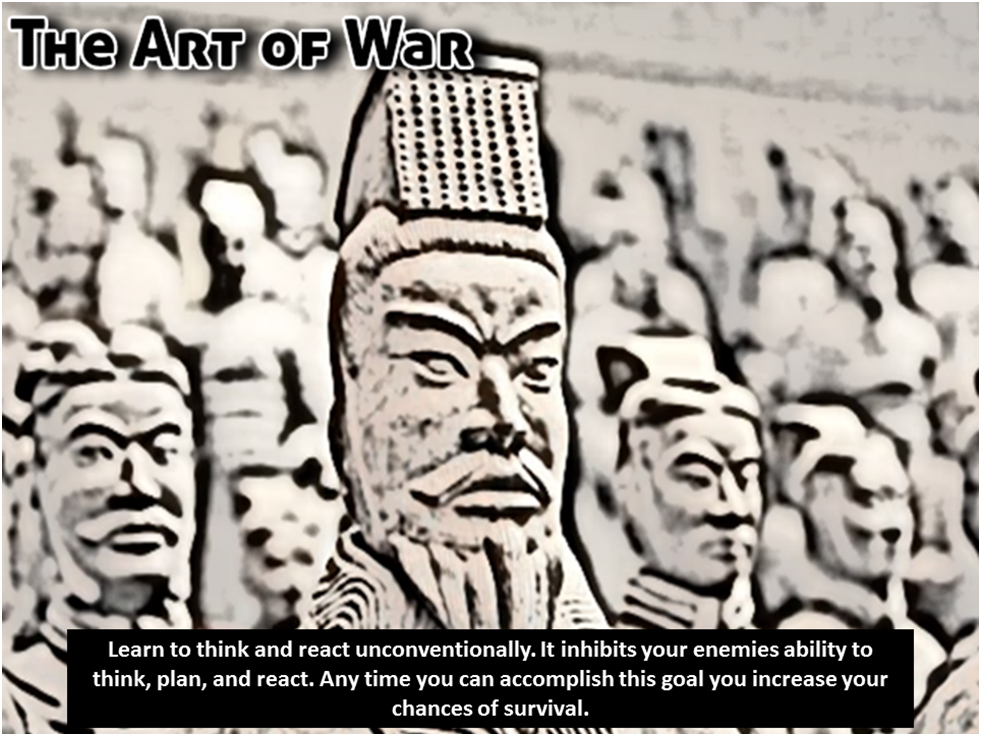The OODA Loop

The OODA Loop is the tactical model of our decision making process developed by USAF Colonel John Boyd and detailed in his military treatise “A discourse on winning and losing”. OODA is an acronym for (Observe, Orient, Decision, and Action). The model continues to be used for Command and Control (C2) functions in military operations, often amalgamated with cybernetic theory, and/or game theory. Col. Boyd developed the model to increase combat effectiveness and survivability in military operations. The model while military in nature is now also commonly utilized by Law Enforcement, the corporate sector, and a plethora of other organizational structures.
Col. Boyd theorized that ourability to make decisions occurs in an endlessly recurring cycle of observe-orient-decide-act. When applied to workplace violence prevention or your personal safety it means that the person/corporation that understands and can apply this process of observing and reacting to unfolding events can gain a distinct tactical advantage over those that mean us harm.
Col. Boyd developed the model to increase the survivability of USAF pilots through a process that strongly influenced modern battlefield training, and tactics. The OODA Loop has also proven invaluable when applied to workplace violence prevention and your personal safety. Col. Boyd emphasized that “the loop” is actually a set of interacting loops that continuously cycle during a crisis. He also indicated that the phase of the crisis has an important bearing on the ideal allocation of manpower and resources.
The diagram of the OODA Loop shows that decisions are based on observations of the evolving threat matrix tempered with implicit filtering of the threat being addressed. These observations are the raw information on which all decisions and actions are based. The observed information must be processed to orient it for decision making. Col. Boyd observed that the second “O”, orientation is the most important part of the ODDA loop since it shapes the way we observe, the way we decide, and the way we act. This observation quite aptly points out that our orientation is determined by our genetic heritage, previous life experience, and cultural traditions.
What you’ll immediately notice is that the OODA Loop really isn’t a loop at all. Rather it is a staged model containing multiple loops. As Col. Boyd developed the model and elaborated on the “Orient” phase, it progressed from simply representing a physical orientation to the inclusion of cognitive, genetic, experiential, and societal orientation as well.
The OODA Loop was designed to describe the decision making process for a single individual, which is ideal for your personal safety planning. When it comes to workplace violence prevention however, the situation becomes murkier and fractured, as most corporations have teams of people observing and orienting, each bringing their own cultural heritage, genetic memory and previous personal experiences into the mix. It is here that decisions often get bogged down, which can have potentially fatal consequences.
The jist of the OODA Loop is that in order to survive a dangerous situation, we must operate at a faster, more efficient pace than the threat we are facing. Conversely we can also attempt to get inside the threat’s own OODA loop and disrupt their ability to operate or plan effectively. This employs many of the principles of asymmetric warfare, the intelligence cycle and can effectively generate confusion, uncertainty, and disorder amongst the threat facing us.
Looking at the model can be a daunting task. Probably the easiest way to navigate it is to imagine that we are faced with a threat. Interaction and engagement with the threat flows both ways. Our orientation is determined by the factors that were outlined previously (genetic, cultural, experiential) and can be enhanced by good situational awareness. It is this orientation/awareness that enables us to engage in behaviors that the threat will be ill prepared to deal with due to the fact that they are irregular, unexpected, and counter-intuitive to the actions and goals of the threat. This is another of the fundamental precepts of asymmetric warfare.
Asymmetric warfare is a concept that was implemented and utilized with great success by the Chinese General Sun Tzu between 544-496 BC. The concepts of asymmetric warfare have long since been applied to business and were immortalized in General Tzu’s famous military treatises “The Art of War”, and the “Cheng Chi.” When you examine both the OODA Loop and the concept of asymmetric warfare it quickly becomes apparent that any time we can engage in any activity or behavior that inhibits the threats ability to think, plan, react, or function is desirable.
It becomes apparent, that when applied to workplace violence prevention and the bureaucracy that is prevalent in most modern corporations utilizing the OODA Loop as a top down method for decision making is unwieldy and too slow to be responsive in a crisis. Instead the OODA Loop should be taught, and utilized at the individual (micro) level rather than the corporate (macro).
So this begs the question of how all of this applies to preventing incidents of workplace violence, and increasing your personal safety? Consider an Active Shooter scenario in your workplace. You hear the sounds of gunfire and people screaming. Panic and confusion abound, and before the shooter is even within visual contact range, staff are attempting to interpret any available information about the likely identity/location of the threat, their knowledge of the building and people within, their level of training, and a multitude of other factors that will come into play.
When the shooter initiates contact, more direct information about the nature and intention of the threat becomes available. Staff will make initial decisions based on the information available about the threat, and the OODA cycle begins. Staff encountering the shooter may make the decision to act, and attempt to escape and evade the threat, shelter in place, or engage the threat directly. The staff then reverts back to the “Observe” phase of the loop to evaluate the threats reaction to their initial decision/action. Does the threat see them run from the room, hide under the desk, or arm themselves for combat? The cycle then continues to the “Orient” phase of the loop. Does the threat react characteristically, or predictably, or do they behave in an unconventional manner?
As the assault progresses precious little time is devoted to orienting unless some new information pertaining to the threats identity or their intent becomes apparent. Information overload and target fixation kick in as both the staff and the threat experience the Adrenal Stress Response associated with all potentially life threatening or stressful situations. Under these circumstances, no one has enough time to process all of the information at a conscious level. Staff facing the threat will react in accordance to their level of training and experience, while their thoughts are directed to processing the flow of incoming data, and the action and reaction between the assailant and the target. Both the staff facing the threat and the assailant continuously repeat the OODA Loop for the duration of the incident.
A common question raised is; how do we get inside the OODA Loop of someone who means to harm us? One of Col. Boyd’s brilliant insights was that in combat, it is vital to change speed and direction faster than the threat facing us. When applied to our Active Shooter scenario it does not necessarily refer to the staff’s physical ability to maneuver, rather it implies that the staff must think and act faster than the threat can. Getting “inside” the threat’s OODA Loop can effectively impede their thought processes and creates opportunities for the opponent to make mistakes that can be capitalized on.
One of the primary lessons that Boyd’s OODA loop can teach is that survival skills such as escape and evasion, and self defense tactics must be properly embedded into our long term, and muscle memory. This is in direct response to the Adrenal Stress that affects everyone in high risk or life threatening situations. In a crisis, it is vital to be able to progress through the OODA loop as quickly and effectively as possible in order to increase your odds of survival.
The most effective way to progress through the loop is to quickly orient to what is happening and bypass the decision-making process by already knowing what action to take based on the stimulus. Boyd called the process of bypassing steps of the OODA loop “implicit guidance and control.” This goal can be accomplished through realistic saturation training. Implicit guidance and control is an unconscious preplanned physical response to a known threat, which is also referred to as a “learned automatic response.”
In order for safety training to be effective, its goals, tactics, and training must be embedded into your neural pathways (Muscle Memory). For the purpose of workplace violence prevention and personal safety, training must be realistic, simple and account for the Adrenal Stress Response. Working in an office environment is rife with dangers, seen and unseen (Statistics indicate you have an 18% higher chance of being a victim of violence working in an office, than if you work in a prison). Being able to survive a crisis is directly proportional to your ability to initiate your safety plan and your ability to implement, and rely on predetermined survival responses.
Building these skill sets is accomplished by using reality based saturation training. In order for training to be maximally effective it must utilize at least two senses and be relevant to the trainee and situation. When a skill is encoded into your neural pathways, the body physically builds synaptic connections between the brain and your muscle fibres. These connections help form your muscle memory, and reactive patterns. Much like physical training, the more you engage your brain the stronger the connections become. This process must include both physical and mental training.

A simple way to understand how this process works is to imagine two roadways representing the synaptic connections in your brain. The first road is an old country back road. The road is littered with pot holes and ruts. It runs next to a steep cliff and has no guard rail. The road is in terrible condition because it was built quickly with little thought about safety or effectiveness. Failure to properly maintain the road has caused it to become more and more unstable as the concrete degrades and crumbles on the shoulders next to the cliff. You need to navigate this road carefully as it is chocked full of potential dangers and pitfalls.
The only reason you built the road in the first place is because you were told to do so by an instructor who informed you that you only had to drive on it once to demonstrate that you understand the concepts of its construction. This happens all the time in training when both the trainer and the trainee believe that the training is purely conceptual in nature and will likely not need to be utilized in the real world.
The second road is a multilane highway that you and your brain can travel at high speed. The roadway is smooth, safe, well designed and functional. Building this road you put a lot of time, effort, and physical expense into its completion, and you understand that you must properly maintain it so that it will be safe to travel on if and when you need it. You employed expert help in its construction it to make certain the road is straight, level and appropriate for how it is to be used. You built it this way because you understood there is a possibility that you may need to use this road to get you out of trouble and to safety quickly in an emergency.
To understand why we want skill sets integrated into your long-term unconscious memory, you should be familiar with Hicks Law, which describes the time it takes for a person to make a decision as a result of the possible choices he or she has. Increasing the number of choices increases the decision time logarithmically. Hicks Law assesses cognitive information capacity in choice reaction decisions. In other words; the amount of time taken to process a certain amount of information in the Hicks Law is known as the “rate of gain of information.” According to this theory, if you have to think before reacting, your body will suffer an approximately half-second delay. On the other hand, if you unconsciously react to a threat or stimulus, your reaction time is a fraction of that time.
With these images in your mind, think about which road you’d prefer your brain to utilize while in a high risk situation. When you have a greater understanding of how the OODA loop works, and how skills are embedded into your long-term unconscious memory, and how these affect your physical responses to a threat it becomes clear why there is a need for reality based saturation training. Not only can the training assist you in properly orienting and responding to a threat, it can help you avoid improper/ineffective responses.
Unfortunately, people are sometimes improperly trained, and bad habits are not corrected and allowed to continue. When this happens, staff, managers and clients are placed in situations that may lead to injury or death. Take, for example the changes in how law enforcement officers are now trained. In the past firearms training was a static exercise conducted on a range offering minimal realism to the environment where the officers in training would have to operate in the course of their duties.
Range masters would frequently admonish trainees to “police your brass.” This means to stop and pick up the spent shell casings that are ejected from their firearm after emptying their magazine. The reasons behind “policing your brass” are good (safety, liability, efficiency), however what is now known about training is; we will perform in the real world exactly the same way as we do in training. The policy of policing brass caused needless officer injury or deaths as during fire fights officers would stop shooting to pick up their spend shell casings instead of engaging the threat. Meanwhile the perpetrator continued to shoot at them and close the reactionary gap.
In order to help increase the effectiveness and efficacy of your own training, we owe it to ourselves and those we train to ensure that we, as trainers, and supervisors know and understand how the OODA loop works and how to maximize our training for survival. Take the time to closely look at your physical traits and habits at work. Could you be unknowingly setting yourself up for failure?
This is a re-posted article, unfortunately I do not remember where I originally picked it up. When I find out, I will give credit to the author and the website accordingly. Thank you for the understanding.


